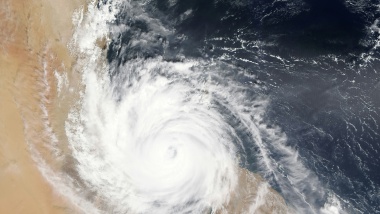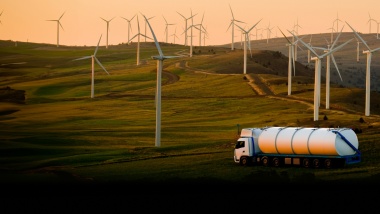What Do the Outcomes of COP26 Mean for Insurers?

By Maryam Golnaraghi
Director Climate Change and Environment
The highly anticipated 26th session of the Conference of Parties (COP) meeting in Glasgow, known as COP26, was the largest United Nations (UN)-convened gathering of private-sector leaders, including from insurance and finance, technology and engineering. Delegates from over 192 governments participated, ultimately negotiating the official outcome document, The Glasgow Climate Pact.1
This article summarises climate-negotiation developments and ongoing challenges under seven key areas: politics and policy; finance; climate risk assessment and reporting standards; climate-related regulatory actions and capital requirements; technology for transitioning; building community resilience including the role of nature-based systems; and carbon trading markets, offering important insights on the implications for insurers.
Seven key takeaways from COP26 and the implications for insurers
1. There has been incremental progress on international and national policies related to the transition to net zero.
However, COP26 fell short of increasing ambitions to reduce emissions to limit the temperature increase to 1.5o C, as the Nationally Determined Contributions (NDCs) submitted by governments prior to COP26 fell significantly short of expectations. Importantly, however, The Glasgow Climate Pact contains the first-ever explicit mention of 'coal' and 'fossil fuels' in a climate change framework agreement, calling on the parties, in Para 20, to 'accelerate efforts towards the phase down' of 'unabated coal power' and 'phase out' of 'inefficient fossil fuel subsidies…'
Notable announcements:
- Global Methane Pledge – 103 countries, accounting for ~70% of world’s GDP, committed to reduce methane emissions by 2030 by 30% of 2020 levels;
- Global pledge to stop deforestation – 110 countries pledged USD 19 billion;
- Global Coal to Clean Power Transition Statement – 23 countries commit to phase out coal, includes five of world’s top 20 coal users
- India targeting net zero by 2070; 50% of electricity in India is currently generated using coal;.
What does it mean for insurers?
In light of the large gap between published NDCs and expected decarbonisation targets in 2030 established by scientists, policy risk remains elevated. However, the first-time appearance of terms ‘unabated coal’ and ‘fossil fuel subsidies’ in the climate change framework agreements may be a sign that domestically, governments are taking a deeper look at plans and policies for phasing out these carbon-intensive sources. As governments prioritise their domestic plans for decarbonisation and building resilience to climate risk, there are significant opportunities for engaging with insurers to find pathways for de-risking and financing their transition.
As governments prioritise their domestic plans for decarbonisation and building resilience to climate risk, there are significant opportunities for engaging with insurers to find pathways for de-risking and financing their transition.
2. Private finance is critical in the net-zero transition.
The Glasgow Financial Alliance for Net Zero (GFANZ) announced a commitment by 450 financial institutions, managing more than USD 130 trillion in assets, for financing the global transition.2 This GFANZ brings together a number of net-zero alliances: Net-Zero Asset Owner Alliance, Net-Zero Asset Manager Alliance, and the Net-Zero Insurance Alliance. Recognising the importance of these developments, stakeholders have called on GFANZ for clear targets and plans. On the other hand, sceptics are concerned about already-financed ‘carbon-intensive energy’ projects by the financial sector that would take the world to above 1.5 oC, if implemented.
What does it mean for insurers?
Many insurers have already signed up to the net-zero alliances and are working to identify pathways for contributing to the global transition through their innovation and engagement as risk managers and investors with their insureds and investees. No company can do this alone; industry alliances are needed to identify scalable solutions.
3. Global baseline standards for sustainability reporting with a focus on climate change are underway.
Importantly, the International Financial Reporting Standards Foundation (IFRS) announced the establishment of the International Sustainability Standards Board (ISSB), building on the work of the Task Force on Climate-Related Financial Disclosures (TCFD). This is a response to the call from the financial and insurance sectors for convergence towards baseline standards for reporting, to support informed decision making.
What does it mean for insurers?
The need for appropriate base standards have been stressed by the insurance industry through the Geneva Association’s Task Force on Climate Risk Assessment,3 with a focus on developing methodologies that would produce decision-useful information for companies, investors and regulators. As the IFRS Foundation develops the governance of ISSB, the insurance industry and the Geneva Association Task Force will engage proactively to offer the industry’s expertise in this area.
4. Regulatory actions related to mandatory disclosures and capital requirements for climate risks are imminent.
The Network for Greening of the Financial System (NGFS) announced that 100+ central banks have signed the NGFS Glasgow Declaration committing to advance supervisory practices.4 In addition, the Bank of England announced that it will be actively supervising firms on climate-related financial disclosures.
What does it mean for insurers?
Regulatory risks associated with mandatory reporting as well new capital requirements for banks and insurers, if not based on reliable forward-looking climate risk information, could hinder the abilities of the financial sector and insurers to support the transition. Financial and insurance regulatory efforts need to be well aligned with public policy; regulatory regimes should enable and incentivise transitioning to a resilient low-carbon economy, with requirements for companies to take appropriate climate change mitigation and adaptation actions.
Regulatory risks associated with mandatory reporting as well new capital requirements for banks and insurers, if not based on reliable forward-looking climate risk information, could hinder the abilities of the financial sector and insurers to support the transition.
5. Public- and private-sector efforts are gaining momentum for the large-scale deployment of new technologies for energy and other sectors to transition to net zero.
The official, negotiated document calls on Parties to expedite the development, deployment and dissemination of new technologies and adoption of policies for transitioning to low-emission energy systems. The intergovernmental body, Mission Innovation, as well as private-sector, investor-led initiatives, e.g. Breakthrough Energy, the World Economic Forum’s Mission Possible Partnership and the Alliance of CEO Climate Leaders, are working to mobilise capital for new technologies to accelerate decarbonisation (e.g. hydrogen, green steel, sustainable aviation fuel, carbon capture).
What does it mean for insurers?
The growing momentum around scaling up technological innovations towards net zero offers new opportunities for insurers as risk managers and investors. New technologies and processes come with untested risks which need to be managed to incentivise adoption, enable large-scale deployment and raise private capital. Insurers play a vital role in assessing, pricing and managing risks related to untested technologies for sectors to transition to net-zero emissions. Innovations in insurance products and services are needed to support adoption and large-scale deployment, where market conditions allow.5 This would require deeper cross-sectoral partnerships with other stakeholders such as governments, technologists and companies from other sectors, enhanced coordination of public and private investments, and governments providing enabling environment to incentivise market development and boost demand.
6. Global recognition of the need to strengthen climate change adaptation and community resilience, including the important role of nature-based systems.
Related developments:
- Parties have agreed to launch the two-year ‘Glasgow-Sharm el Sheikh Work Programme on the Global Goal on Adaptation’ (The GlaSS) offering an opportunity for public-private engagements to reduce vulnerability, strengthen resilience and increase the adaptive capacity to the impacts of climate change.6
- The Adaptation Fund raised USD 356 million in new pledges at COP26. However, there is a history of partial payments of such pledges. Availability of these funds is critical for developing resilience solutions for most vulnerable nations.7
- 5% of proceeds from the new market-based UNFCCC mechanism to contribute to the mitigation of greenhouse gas emissions will go to the Adaptation Fund to support adaptation projects in developing countries around the world. This is particularly important to incentivize governments and companies put more funds into adaptation measures.8
- Race to Resilience Initiative partners announced many initiatives for measuring and building resilience (related to cities, infrastructure, agriculture, etc.), covering 2.3 billion people, over 100 countries and 100 natural systems.
- The Global Resilience Index Initiative (GRII), a partnership engaging the insurance industry, academia, the United Nations and the World Bank aims to develop curated, open-source resources offering high-level metrics across the built environment, infrastructure, agriculture and societal exposures.9
- Biodiversity and nature-based solutions, such as mangroves, wetlands and coral reefs, have demonstrated that they serve as a buffer, increasing community resilience to extreme events.
What does it mean for insurers?
Emphasis on climate change adaptation and building societal resilience as well as the recognition of the role of the insurance industry offer opportunities for governments, the financial sector, development banks and international development entities to partner in expanding sustainable insurance markets around the world to address the growing protection gap against extreme weather. Furthermore, building on efforts such as the Coalition for Climate Resilient Investment,10 the insurance industry, governments and the private sector should further enhance cooperation around developing resilient infrastructure systems, for example in risk assessment and risk management.11 In addition, the insurance industry has proactively engaged with the Taskforce on Nature-related Financial Disclosures (TNFD).
The insurance industry, governments and the private sector should further enhance cooperation around developing resilient infrastructure systems.
7. There are new rules for establishing market mechanisms for trading carbon.
A new framework for Carbon Trading Market Offsets presents revised rules for countries and companies trading carbon, for transparency and validation to prevent double-counting. However, the acceptable use of credits as part of net-zero plans is still heavily debated. A new Voluntary Carbon Markets Integrity (VCMI) Initiative, a global multistakeholder platform, will help ensure that voluntary carbon markets (VCMs) make a positive, significant and measurable contribution to the transition of the global economy to a 1.5°C future.12
What does it mean for insurers?
Insurers have the opportunity to work with other key stakeholders to increase their offering of innovative insurance offers for both technological solutions for carbon capture and storage as well as for the protection of natural ecosystems that serve both as a carbon sink and as a resilience buffer, which could accelerate the flow of capital for implementation of these projects. Furthermore, insurers can continue to promote the establishment of clear carbon-pricing regimes with governments.
Finally, disappointments with the outcomes of COP26 could lead to a potential rise in climate litigation risk against governments and corporations. Proactive, well-planned transitioning should happen in this decade to put the world on the path to meeting climate targets by 2050. Over 50% of total recorded climate litigation cases between 1986 and 2020 were brought after the Paris Agreement.13, 14 Similar patterns may emerge from the outcomes of COP26, particularly in the form of strategic litigation against governments, corporations, fund managers and their fiduciaries to push for meaningful climate policy and actions.
References
[1] United Nations. 2021. Glasgow Climate Pact. https://unfccc.int/sites/default/files/resource/cop26_auv_2f_cover_decis...
[2] GFANZ. 2021. Glasgow Financial Alliance for Net Zero: Our progress and plan towards a net-zero global economy. https://www.gfanzero.com/progress-report/
[3] The Geneva Association. 2021a. Climate Change Risk Assessment for the Insurance Industry. February. https://www.genevaassociation.org/sites/default/files/research-topics-document-type/pdf_public/climate_risk_web_final_250221.pdf
[4] NGFS. 2021. The NGFS Glasgow Declaration. https://www.ngfs.net/sites/default/files/ngfsglasgowdeclaration.pdf
[5] The Geneva Association. 2021b. Press release: Insurers Have A Key Role to Play in the Transition to Net Zero by De-risking New Climate Technologies. https://www.genevaassociation.org/news/press-releases/insurers-have-key-...
[6] The Insurer. 2021. Global Resilience Index Initiative launches in Glasgow. https://www.theinsurer.com/cop26/global-resilience-index-initiative-launches-in-glasgow/19296.article.
[7] Ibid.
[8] Ibid.
[9] Ibid.
[10] For more information see https://resilientinvestment.org/
[11] The Geneva Association. 2019. Investing in Climate-resilient Decarbonised Infrastructure to Meet Socio-economic and Climate Change Goals. Author: Maryam Golnaraghi. December. https://www.genevaassociation.org/research-topics/climate-change-and-eme...
[12] VCMI. 2021. Roadmap: Ensuring High-Integrity Voluntary Carbon Markets. https://vcmintegrity.org/wp-content/uploads/2021/10/Roadmap_Final.pdf?
[13] The Geneva Association. 2021c. Climate Change Litigation – Insights into the Evolving Global Landscape. Authors: Maryam Golnaraghi, Joana Setzer, Nigel Brook, Wynne Lawrence and Lucia Williams. April. https://www.genevaassociation.org/sites/default/files/research-topics-document-type/pdf_public/climate_litigation_04-07-2021.pdf
[14] The Washington Post. 2021. Drowning Nations Disappointed with Outcomes of U.N. Climate Summit May Have One Move Left. Lawsuits. https://www.washingtonpost.com/world/2021/11/17/island-nations-climate-legal-action/





